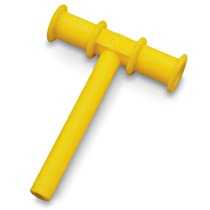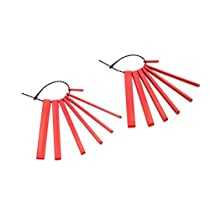Oral movements required for feeding and speech includes fine and controlled movements of the articulators such as the jaw, lip, and tongue. The movements of these articulators are said to be fine when the child has normal muscle tone, adequate muscle strength, range of motion, speed, coordination and dissociation (the ability to move oral structures, such as the tongue and lip, independently of each other).
WHY MUSCLE TONE IS IMPORTANT?
In normal muscle tone there is the right amount of tension in the muscle and the muscle is in a
prepared state to contract appropriately on command. Muscle tone helps in maintaining body
posture. For instance, the muscles holding the jaw keep it in position by contracting ontinuously and only partially. There are two types of muscle tone:
- Low muscle tone or hypotonia and
- High muscle tone or hypertonia
Low muscle tone or Hypotonia refers to decreased muscle tone, often involving reduced muscle strength. It is commonly seen (but not limited) in children with Down Syndrome and Cerebral Palsy (flaccid).
High muscle tone or Hypertonia is a condition in which there is increased tension in muscle
tone – the arms or legs, for example, are stiff and difficult to move. It is commonly seen (but not
limited) in children with Cerebral Palsy (spastic) and Traumatic Brain Injury (TBI).
As a result, when there is deviancy in the state of the muscle tone it affects the posture and fine
controlled movements required for feeding and speech.
HOW WILL YOU IDENTIFY ORAL WEAKNESS RESULTING DUE TO ABNORMAL MUSCLE TONE?
 Oral muscle weakness can be seen due to congenital or traumatic central nervous system damage. Individuals with oral muscle weakness might show reduced muscle strength, reduced speed of movement, reduced range of movement, poor dissociation (independent muscle movement) and reduced accuracy of movement required for feeding and speech. When the child has low muscle tone or hypotonia (e.g., Down Syndrome and Flaccid CP), they have little or no control of their neck muscles, so their head tends to flop. They often have their mouth open due to low muscle tone at the level of jaw. They have weak lips, as a result of which they have trouble in closing their lips to drink from a straw or a cup and
Oral muscle weakness can be seen due to congenital or traumatic central nervous system damage. Individuals with oral muscle weakness might show reduced muscle strength, reduced speed of movement, reduced range of movement, poor dissociation (independent muscle movement) and reduced accuracy of movement required for feeding and speech. When the child has low muscle tone or hypotonia (e.g., Down Syndrome and Flaccid CP), they have little or no control of their neck muscles, so their head tends to flop. They often have their mouth open due to low muscle tone at the level of jaw. They have weak lips, as a result of which they have trouble in closing their lips to drink from a straw or a cup and
often lose control of liquids while trying to drink. A weak tongue makes it hard to move the food
around in the mouth while eating.
A child with high muscle tone (e.g., Spastic CP) shows increased stiffness at the level of neck,
cheeks, jaw, lip, and tongue. This makes it difficult to execute voluntary movements in an
adequate manner. It results in resistance to movement that is generally more pronounced at the
beginning of movement or in response to quick movements. So overall reduced range of
movements and lack of coordination of articulators can be seen.
Children with either hypo/hypertonia show the following common signs, such as
- Poor feeding skills
- Poor lip closure
- Poor sucking
- Poor blowing
- Drooling
- Fixation of articulators (jaw, lip and tongue)
- Difficulty in producing speech sounds
- Running out of air before finishing the phrase
HOW IS MUSCLE TONE CONNECTED TO FEEDING AND SPEECH CLARITY?
Oral muscle weakness affects the function of the oral mechanism that impacts the modalities of feeding and speech production.
FEEDING
 Low muscle tone or high muscle tone in the facial muscle can result in an open mouth posture.
Low muscle tone or high muscle tone in the facial muscle can result in an open mouth posture.
Stability of the jaw allows the tongue to move independently within the mouth, but when the jaw
remains open, it prevents dissociation (independent muscle movement) resulting in an immature pattern in which the tongue and jaw move together. Moreover, wide jaw excursions decrease the ability to manipulate food within the oral cavity increasing the possibility of food falling out of the mouth or failure to chew smaller pieces of food due to the inability to grade movement. Since their tongue moves in and out, as opposed to side to side, these children are not exhibiting the oral-motor pattern that would enable them to adequately chew foods. The lips and cheeks work together providing enough tension within the mouth to contain the food and the lips provide negative pressure to begin the swallowing process. If the lip and cheek muscles become shortened through compensatory motor movements and/or lack of practice, they will not be able to attain full muscle length required for lip closure. Therefore, tonal and muscle imbalance of these structures can leave the lips in an open position. This can result in losing food anteriorly or the inability to contain the food while manipulating it (Alper, & Manno, 1996; Ernsperger, & Hanson, 2004). The resulting pattern appears as though the child is pushing food out the front of the mouth, such as the oral-motor pattern that is typical of many children with Down syndrome and Cerebral palsy.
SPEECH
Speech is the end result of four critical elements of muscle movement: 1) Awareness of the oral
structures, 2) Placement of oral structures, 3) Stability, endurance, and muscle memory, and 4)
Production. Speech production requires the integration of several systems one of which being neuromuscular motor output. If the muscles of the oral mechanism (mouth) do not have adequate strength, they are unable to perform the fine motor movements necessary for feeding and speech.
 The production of speech requires the articulation of sounds to be executed through the precise
The production of speech requires the articulation of sounds to be executed through the precise
movements of speech structures within the musculature of the oral mechanism including the
jaw, lips, cheeks, tongue and palate. When the muscles of this mechanism (such as muscles of
the lips) are weakened, they are unable to make the precise contact necessary to make sounds such as bilabials /m, b, p, w/.
Jaw instability is the most common cause for deterioration of speech clarity when the speed or
complexity of an utterance increases. When the jaw is not stable, the lips and the tongue cannot
do their job for standard speech production.
Speech in an individual with muscle weakness, hence, is often characterised by
mispronunciations of multiple phonemes, consonant deletions, and an overall lack of
intelligibility due to inefficient coarticulation during connected speech.
To know more about the movements needed for feeding and speech, please refer to
The acquisition and maturation of oral-motor movements for sound production and feeding skills
HOW CAN WE NORMALIZE ORAL MUSCLE TONE?
Like every treatment or rehabilitation program, one should begin at the child’s current
performance level and always consider the feeding and speech disturbances. For example, the
oro-facial musculature to be treated is characterized by at least one of the following
abnormalities: increased tone and associated weakness, hyperactive reflexes and
hypersensitivity, therefore it is best to initiate treatment with appropriate techniques.
A variety of exercises can be done in a structured way to help strengthen the muscles in order to improve speech and feeding skills. Examples of this structured program would include, but
would not be limited to the following:
- Sensory massages in and outside the oral cavity
- Horn blowing
- Bubble Blowing
- Jaw activities like the Bite Tube Set, Jaw Grading Bite Blocks.
- Feeding activities like Spoon feeding, Slow Feed and Straw Drinking





The tools mentioned above help in preparing the muscles and creating the movements required
for feeding and speech, like:
- Normalizing the oral tactile sensitivity
- Improving jaw strength, jaw stability and jaw grading
- Improving phonation and fine controlled movement of the lips and tongue (Image 5)
To know more about the structured program we follow at PlayStreet, please do take a read
through our article on Oral Placement Therapy (What is oral placement therapy?), which is a structured program that helps normalize oral muscle tone, create appropriate oral motor movements and improve feeding and speech skills.
To know more about muscle tone, see How much do we know about muscle tone
REFERENCES
- Oral Placement Therapy for Speech clarity and Feeding- Sara Rosenfeld Johnson
- Clinical decision making and oral motor treatment– Heather M. Clark,
- Early Oral-Motor Interventions for Pediatric Feeding Problems: What, When and How – Cecilia J. Manno, Catherine Fox, Peggy S. Eicher and Mary Louise E. Kerwin (2005), JEIBI volume 2, issue no. 3.
- https://www.globaldownsyndrome.org/wp-content/uploads/2018/08/600×355-Feb-2016-Web-Sliders3-4-598×354-1-600×320-1.jpg
- https://www.google.co.in/url?sa=i&url=http%3A%2F%2Fcdss.ca%2Fwp-content%2Fuploads%2F2017%2F06%2FOralsensorimotor.pdf&psig=AOvVaw1i2CaeRkFQxByioq-yX6GZ&ust=1610773159155000&source=images&cd=vfe&ved=0CA0QjhxqFwoTCJDt6PuTne4CFQAAAAAdAAAAABAE
- https://www.google.co.in/url?sa=i&url=https%3A%2F%2Fwww.flintrehab.com%2Fcerebral-palsy-and-down-syndrome%2F&psig=AOvVaw1xOmc1IDNhF1kxO4XLg1Pf&ust=1610773495396000&source=images&cd=vfe&ved=0CA0QjhxqFwoTCMChxoqVne4CFQAAAAAdAAAAABAD



0 Comments